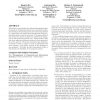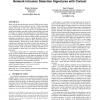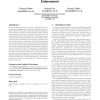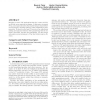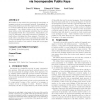92
Voted
CCS
2003
ACM
15 years 4 months ago
2003
ACM
We describe LEAP (Localized Encryption and Authentication Protocol), a key management protocol for sensor networks that is designed to support in-network processing, while at the ...
95
Voted
CCS
2003
ACM
15 years 5 months ago
2003
ACM
After the Code Red incident in 2001 and the SQL Slammer in January 2003, it is clear that a simple self-propagating worm can quickly spread across the Internet, infects most vulne...
82
Voted
CCS
2003
ACM
15 years 5 months ago
2003
ACM
We present a novel solution for authenticating printed paper documents by utilizing the inherent non–repeatable randomness existing in the printing process. For a document print...
98
Voted
CCS
2003
ACM
15 years 5 months ago
2003
ACM
Many network intrusion detection systems (NIDS) use byte sequences as signatures to detect malicious activity. While being highly efficient, they tend to suffer from a high false...
63
Voted
CCS
2003
ACM
15 years 5 months ago
2003
ACM
Ò ÙØÓÑ Ø × ÙÖ ØÝ ÔÖÓØÓ ÓÐ Ò Ö ØÓÖ × ÔÖÓÔÓ× Ø Ø Ù× × ÐÓ ¹ × ×ÝÒØ × × ÖÙÐ × ØÓ Ù Ø Ò Û Ö × Ö ÓÖ ×Ù Ø Ð ÔÖÓØÓ Ó�...
CCS
2003
ACM
15 years 5 months ago
2003
ACM
109
click to vote
CCS
2003
ACM
15 years 5 months ago
2003
ACM
This paper describes a system and annotation language, MECA, for checking security rules. MECA is expressive and designed for checking real systems. It provides a variety of pract...
92
Voted
CCS
2003
ACM
15 years 5 months ago
2003
ACM
Emerging economic P2P applications share the common need for an efficient, secure payment mechanism. In this paper, we present PPay, a micropayment system that exploits unique cha...
90
Voted
CCS
2003
ACM
15 years 5 months ago
2003
ACM
We describe a new method for protecting the anonymity of message receivers in an untrusted network. Surprisingly, existing methods fail to provide the required level of anonymity ...
124
Voted
CCS
2003
ACM
15 years 5 months ago
2003
ACM
Network based intruders seldom attack directly from their own hosts, but rather stage their attacks through intermediate “stepping stones” to conceal their identity and origin...

